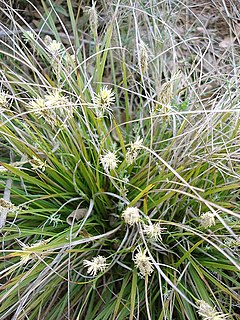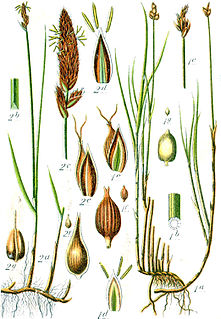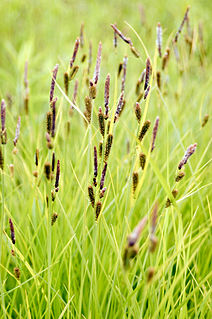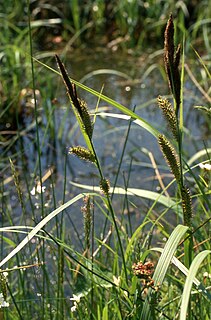
The Cyperaceae are a family of graminoid (grass-like), monocotyledonous flowering plants known as sedges. The family is large, with some 5,500 known species described in about 90 genera, the largest being the "true sedges" genus Carex with over 2,000 species.

Carex is a vast genus of more than 2,000 species of grass-like plants in the family Cyperaceae, commonly known as sedges. Other members of the family Cyperaceae are also called sedges, however those of genus Carex may be called true sedges, and it is the most species-rich genus in the family. The study of Carex is known as caricology.

Carex flacca, with common names blue sedge, gray carex, glaucous sedge, or carnation-grass,, is a species of sedge native to parts of Europe and North Africa. It is frequent in a range of habitats, including grasslands, moorlands, exposed and disturbed soil, and the upper edges of salt marshes. It has naturalized in eastern North America.
Yanal Bog is a 1.6 hectare biological Site of Special Scientific Interest on the southern edge of the North Somerset Levels, just north of the village of Sandford, North Somerset. It was notified as an SSSI in 1988.

Carex lasiocarpa is a broadly distributed species of wetland sedge sometimes known as woollyfruit sedge or slender sedge. It is considered a species of Least Concern by the IUCN Red List due to its extensive range with many stable populations.

Carex chordorrhiza, commonly called creeping sedge or string sedge, is a species of perennial plant in the family Cyperaceae with Holarctic distribution growing in acidic bogs.

Carex rostrata, the bottle sedge or beaked sedge, is a perennial species of sedge in the family Cyperaceae.

Carex stricta is a species of sedge known by the common names upright sedge and tussock sedge. The plant grows in moist marshes, forests and alongside bodies of water. It grows up to 2 feet (0.61 m) tall and 2 feet (0.61 m) wide. When the leaves die, they build on top of or around the living plant, making a "tussock". Widely distributed in and east of the Great Plains, it is one of the most common wetland sedges in eastern North America.

Carex scoparia is a species of sedge known by the common names broom sedge and pointed broom sedge. It should not be confused with the unrelated grass species known as "broom sedge," Andropogon virginicus.

Carex vesicaria is an essentially Holarctic species of sedge known as bladder sedge, inflated sedge, and blister sedge. It has been used to insulate footwear in Norway and among the Sami people, and for basketry in North America.

Carex riparia, the greater pond sedge, is a species of sedge found across Europe and Asia. It grows in a variety of wet habitats, and can be a dominant species in some swamps. It is Britain's largest Carex, growing up to 130 cm tall, with glaucous leaves up to 160 cm long. It hybridises with a number of other Carex species, including the closely related Carex acutiformis – the lesser pond sedge. A variegated cultivar is grown as an ornamental grass.

Carex hirta, the hairy sedge or hammer sedge, is a species of sedge native across Europe. It has characteristic hairy leaves and inflorescences, and is the type species of the genus Carex.

Carex spicata is a species of sedge in the genus Carex.

Carex panicea, commonly known as carnation sedge, is a plant species in the sedge family, Cyperaceae. It is known as grass-like sedge and can be found in Northern and Western Europe, and also in north-eastern North America. The plant produces fruits which are 3–4 millimetres (0.12–0.16 in) long, are egg shaped and spiked. Both male and female species leaves are pale blue on both sides.

Carex sect. Ovales is a section of the genus Carex, containing around 85 species of sedge. It is the most diverse section of the genus in North America, containing 72 species:

Carex albicans, commonly called whitetinge sedge, is a species of flowering plant in the sedge family (Cyperaceae). It is native to the eastern North America, where it is found in Canada and the United States. Its typical natural habitat is dry forests and woodlands.

Carex viridula, known as little green sedge, green sedge, or greenish sedge, is a small flowering plant native to North America, Europe, Asia, and Morocco.
Carex hyalinolepis is a tussock-forming species of perennial sedge in the family Cyperaceae. It is native to southern parts of North America from Ontario in the north to Texas in the south.















